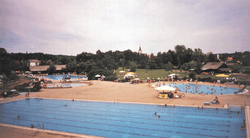Topusko
| Topusko | |
|---|---|
| Commune | |
|
Topusko spa resort with St. Mary's church in the background | |
|
Location of Topusko commune within Sisak-Moslavina County | |
 Topusko Location of Topusko in Croatia | |
| Coordinates: HR 45°17′35″N 15°58′20″E / 45.29306°N 15.97222°ECoordinates: HR 45°17′35″N 15°58′20″E / 45.29306°N 15.97222°E | |
| Country |
|
| County | Sisak-Moslavina |
| Component settlements |
List
|
| Time zone | CET (UTC+1) |
| • Summer (DST) | CEST (UTC+2) |
Topusko is a commune in Sisak-Moslavina County, Croatia. The seat of the commune is the spa town of Topusko. The commune also includes the settlements of Batinova Kosa, Bukovica, Crni Potok, Donja Čemernica, Gređani, Hrvatsko Selo, Katinovac, Mala Vranovina, Malička, Pecka, Perna, Ponikvari, Staro Selo Topusko and Velika Vranovina, Vorkapić
Demographics
The population of the town of Topusko is 945, with a total of 2,985 people in the municipality (census 2011).[1] There are 1865 Croats (62.48%), 893 Serbs (22.27%) and 139 Bosniaks (4.66%).[2]
History
Prehistory and Antiquity
The first traces of humans in the Topusko area were found around 2,500 B.C. Numerous idols, fragments of ceramic dishes were found. Through the millennia, the Illyrians, the Celts, and most of all, the Romans testified to their existence and their fascination with this area of impulsive vivacity, and they made a statio, called Ad Fines.
The excavation of pre-historical artifacts shows that Topusko and its surroundings were inhabited in the Neolithic (8-5 ct. BC). The line of the monuments built in the honour of the Illyrian divinities Vidas and Thiana (Thana), points to the presence of the Illyrians (tribes the Japods and the Kolapijans, 3,000 years BC). In the area of Topusko we can also find traces of some other peoples, for example the Celts, the Goths, the French, the Hungarians etc.
The real development of Topusko begins after the arrival of the Romans. The most crucial event in the history of Topusko would be the building of the Roman road Via Eksecirtualis, which in turn sparked the creation of the Roman colony Ad Fines, which ultimately turned into modern day Topusko. The remnants of the luxurious architecture, the devices for heating the houses with hot water, the painted walls of the houses, the discovered altars dedicated to the Roman and domestic divinities, the grave-monuments, tools, ornaments, money (which was thrown into the thermal springs) are very valuable artifacts that tell us about the persistence of the colony through the whole antiquity.
Middle Ages
Topusko flourishes again in 1192 as a thermal resort in the time of Andrija II, who in the time of his reign built a magnificent chapel of the Blessed Virgin Mary of Pohod in a Gothic style. Its dilapidated front is being kept with all its monumentality in the park "Opatovina". This Cistercian portal today has the status of the unique symbol of Topusko.
King Andrija II goes to the holy war to Jerusalem at the beginning of the 13th century, and makes a vow that in case he comes back he will build a monastery and an abbey in Topusko, in token of gratitude. In 1233 he finishes the chapel and monastery and gives them to the Cistercians. This is their first monastery in Croatia, and the edifice itself is the first one built in Gothic style in the area south from France. The three hundred year dominance of the Cistercians began to weaken in wars with the Turks, who broke towards Vienna through these areas. Under the leadership of the Bosnian pasha Makoc beg, the Turkish troops destroyed the abbey in 1558. Only the front of that monumental edifice remained.
18th century to the present
In the year 1784 Topusko and the abbey belong to the Croatian Military Border and remains under its conduct for about a hundred years. The real development of Topusko we can follow in a well-documented manner begins only after the arrival of colonel Ivan Nestor. Colonel Nestor started the development of Topusko, but the turning point was the arrival of the king Francis II in 1818, and the repeated donation of money for the construction. Therefore, Ivan Nestor is with good reason considered to be "the real father of Topusko".
The next stronger phase in the development followed the arrival of ban Josip Jelačić (later the count and the governor of Croatia). At that time also the capital objects are built and Topusko stands out from the common bathing resort and becomes a fashionable bathing-place.
In the late 19th and early 20th century, Topusko was a district capital in the Zagreb County of the Kingdom of Croatia-Slavonia.
During the World War II, Topusko hosted 3rd session of ZAVNOH, the highest governing organ of the anti-fascist movement in Croatia, during which, on May 9, 1944, the Federal State of Croatia was formally founded.
During the Croatian War of Independence, Topusko was occupied along with other towns by the unrecognized breakaway Republic of Serbian Krajina. It was returned to Croatian control during Operation Storm.
HQ Sector North UNPROFOR was located in Topusko in the period 1992 - 1995.
Notable people
- Joseph Schlessinger - biochemist and biophysician
See also
References
- ↑ "Population by Age and Sex, by Settlements, 2011 Census: Topusko". Census of Population, Households and Dwellings 2011. Zagreb: Croatian Bureau of Statistics. December 2012.
- ↑ "Population by Ethnicity, by Towns/Municipalities, 2011 Census: County of Sisak-Moslavina". Census of Population, Households and Dwellings 2011. Zagreb: Croatian Bureau of Statistics. December 2012.
External links
| Wikimedia Commons has media related to Topusko. |
- Official website (Croatian)
